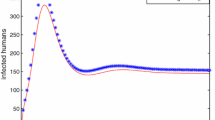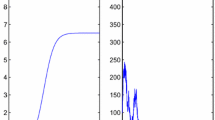Abstract
In this research article we have developed a mathematical model to describe the spread of avian influenza A (H7N9) virus from the birds to human. We also consider the incubation periods of avian influenza A (H7N9) virus in this model with different time delay in the infective avian and human populations. By analyzing behaviour of the model, we calculate the basic reproduction number and investigate the local and global stability of equilibria of the system. Here we also set up an optimal control problem and used a quadratic control to reduce the spread of the disease and the cost of treatment. Computer simulations are carried out to explain the analytical findings.










Similar content being viewed by others
References
Alexander DJ (2007) An overview of the epidemilogy of avian influenza. Vaccine 25:5637–5644
Bao C, Cui L, Zhou M, Wang LH (2013) Live-animal markets and influenza A (H7N9) virus infection. New Eng J Med 368:2337–2339
Chen Y, Liang W, Yang S, Wu N, Gao H (2013) Human infections with the emerging avian influenza, A H7N9 virus from wet market poultry; clinical analysis and characterissation of viral genome. Lan 381:1916–1925
Geo H (2013) Clinical finding in 111 cases of influenza A(H7N9) virus infection. New Eng J Med 368:2277–2285
Kim KI, Lin Z, Zhang L (2010) Avian-human influenza epidemic model with diffusion. Nonlin Anal Real World Appl 11:313–322
Li Q, Zhou L, Zhou M, Chen Z, Li F, Wu H, Xiang N, Chen E et al (2014) Epidemiology of human infections with avian influenza A (H7N9) virus in China. New Eng J Med 370:520–532
World Health Organisation (WHO) (2014) Human infection with avian influenza A (H7N9) virus (update). http://www.who.int/csr/don/2014-02-24/en/
World Health Organization (WHO) (2015) Influenza. http://www.who.int/topics/influenza/en/
World Organisation for Animal Health (OIE) (2013) OIE expert mission finds live bird markets play a key role in poultry and human infections with influenza A (H7N9). Paris. http://www.oie.int/en/for-the-media/press-releases/detail/article/oie-expertmission-finds-live-bird-markets-play-a-key-role-in-poultry-andhuman-infections-with-infl/
Arqub OA, Ajou AE (2013) Solution of the fractional epidemic model by homotopy analysis method. J King Saud Univ Sci 25:73–81
Huang G, Takeuchi Y, Ma W, Wei D (2010) Global stability for delay SIR and SEIR epidemic models with nonlinear incidence rate. Bull Math Biol 72:1192–1207
Keeling MJ, Rohani P (2008) Modeling infectious diseases in humans animals. Princeton University Press, Princeton
Smadi MA, Freihat A, Arqub OA, Shawagfeh N (2015) A novel multistep generalized differential transform method for solving fractional-order Lu Chaotic and hyperchaotic systems. J Comput Anal Appl 19:713–724
Iwami S, Takeuchi Y, Liu X (2007) Avian-human influenza epidemic model. Math Biosci 207:1–25
Iwami S, Takeuchi Y, Korobeinikov A, Liu X (2008) Prevention of avian influenza epidemic: what policy should we choose? J Theor Biol 252(4):732–741
Iwami S, Takeuchi Y, Liu X (2009) Avian flu pandemic: can we prevent it? J Theor Biol 257:181–190
Iwami S, Takeuchi Y, Liu X, Nakaoka S (2009) A geographical spread of vaccine-resistance in avian influenza epidemics. J Theor Biol 259:219–228
Kwon JS, Lee HJ, Lee DH (2008) Immune responses and pathogenesis in immunocompromised chickens in response to infection with the H9N2 low pathogenic avian influenza virus. Virus Res 133(2):187–194
Wang H, Feng Z, Shu Y (2008) Probable limited person-to-person transmission of highly pathogenic avian influenza A(H5N1) virus in China. The Lancet 371(9622):1427–1434
Jung E, Iwami S, Takeuchi Y, Jo TC (2009) Optimal control strategy for prevention of avian influenza pandemic. J Theor Biol 260:220–229
Gumel AB (2009) Global dynamics of a two-strain avian influenza model. Int J Comput Math 86:85–108
Agusto FB (2013) Optimal isolation control stategies and cost-effectveness analysis of a two-strain avian influenza. Biosystem 113:155–164
Ma X, Wang W (2010) A discrete model of avian influenza with seasonal reproduction and transmission. J Biol Dyn 4:296–314
Bourouiba L, Gourley SA, Liu R, Wu J (2011) The interaction of migratory birds and domestic poultry and its role in sustaining avian influenza. SIAM J Appl Math 71:487–516
Gourley SA, Liu R, Wu J (2010) Spatiotemporal distributions of migratory birds: patchy models with delay. SIAM J Appl Dyn Syst 9:589–610
Tuncer N, Martcheva M (2013) Modeling seasonality in avian influenza H5N1. J Biol Syst 21:130
Chong NS, Tchuenche JM, Smith RJ (2014) A mathematical model of avian influenza wiyh half-saturated incidence. Theory Biosci 133:23–38
Liu S, Ruan S, Zhang X (2015) On avian influenza epidemic models with time delay. Theory Biosci 134:75–82
Cooke KL, Van Den Driessche P (1996) Analysis of an SEIRS epidemic model with two dealys. J Math Biol 35:240–260
Beretta E, Hara T, Ma W, Takeuchi Y (2001) Global aymptotical stability of an SIR epidemic model with distributed time delay. Nonlinear Anal 47:4107–4115
Beretta E, Takeuchi Y (1995) Global stability of an SIR model with time dealys. J Math Biol 33:250–260
Ruan S, Wei J (2003) On the zeros of transcendental functions with applications to stability of delay differential equations with two delays. Dyn Contin Discrete Impulse Syst Ser A Math Anal 10:863–874
Ruan S, Xiao D, Beier JC (2008) On the delayed RossMacdonald model for malaria transmission. Bull Math Biol 70:1098–1114
Samanta GP (2010) Permanence and extinction for a nonautonomous avian-human influenza epidemic model with distributed time delay. Math Comput Model 52:1794–1811
Hale JK (1969) Ordinary Differential equations. Wiley, New York
Hale JK (1977) Theory of functional Differential Equations. Springer, Heidelberg
Anderson RM, May RK (1991) Infections diseases of humans; dynamics and control. Oxford University Press, Oxford
Blayneh K, Cao Y, Kwon HD (2009) Optimal control of vector-borne disease: treatment and prevention. Disc Cont Dynam Sys Ser B 11:1–31
Lcnhart S, Workman JT (2007) Optimal control applied to biological mathods. Chapman and Hall/CRC, London
Joshi HR (2002) Optimal control of an HIV immunology model. Optim Control Appl Methods 23:199–213
Sharma S, Samanta GP (2013) Dynamical behaviour of a tumor-immune system with chemotherapy and optimal control. J Nonlinear Dyn. https://doi.org/10.1155/2013/608598
Sharma S, Samanta GP (2015) An analysis of the dynamics of a tumore-immune system with chemotherapy and immunotherapy and quadratic optimal control. Differ Eq Dyn Syst. https://doi.org/10.1007/s12591-015-0250-1
Sharma S, Samanta GP (2014) Analysis of a Chlamydia model. J Biol Syst 22(4):1–32
Sharma S, Samanta GP (2016) Analysis of a hand-foot-mouth disease model. Int J Biomath. https://doi.org/10.1142/S1793524517500164
Swan GW (1984) Applications of optimal control theory in biomedicine. Marcel Dekker, New York
Tchuenche JM, Khamis SA, Agusto FB, Mpeshe SC (2011) Optimal control and sensitivity analysis of an influenza model with treatment and vaccination. Acta Biotheor 59:1–28
Zaman G, Kang YH, Jung H (2008) Stability analysis and optimal vaccination of an SIR epidemic model. Biosystem 93:240–249
Fleming WH, Rishel RW (1975) Deterministic and stochastic optimal control. Springer, New York
Lukes D (1982) Differential equations: classical to controlled, mathematics in science and engineering. Academic Press, New York
Pontryagin LS, Boltyanskii VG, Gamkrelidze RV, Mishchenko EE (1962) The mathematical theory of optimal process. Philadelphia, Philadelphia
Acknowledgements
We would like to thank Department of Mathematics, IIEST, Shibpur for financial support to run the work. The second author is thankful to the University Grants Commission, India for providing SRF (RGNF). The third author acknowledges financial support from UGC, India (MRP No. - PSW-128/15-16 (ERO)). We would also like to thank two anonymous reviewers and editors for their comments and suggestions that improved this manuscript.
Author information
Authors and Affiliations
Corresponding author
Rights and permissions
About this article
Cite this article
Sharma, S., Mondal, A., Pal, A.K. et al. Stability analysis and optimal control of avian influenza virus A with time delays. Int. J. Dynam. Control 6, 1351–1366 (2018). https://doi.org/10.1007/s40435-017-0379-6
Received:
Revised:
Accepted:
Published:
Issue Date:
DOI: https://doi.org/10.1007/s40435-017-0379-6




